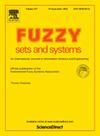二维跳跃系统Roesser模型的模糊有限区域耗散实现及其在换热器动力学中的应用
IF 2.7
1区 数学
Q2 COMPUTER SCIENCE, THEORY & METHODS
引用次数: 0
摘要
本文研究了换热器系统的异步有限区域耗散控制设计。首先,我们采用热力学方法和结合系统随机性和非线性的Takagi-Sugeno (T-S)模糊方案将换热器系统建模为二维马尔可夫跳变系统(mjs)。将隐马尔可夫模型(HMM)与基于系统模式和模糊规则的李雅普诺夫泛函相结合,解决了系统与控制器之间的不同步现象,同时降低了保守性。然后,利用线性矩阵不等式技术,成功地建立了闭环二维mjs是有限域有界且严格(Q,S,R)-ζ耗散的充分条件。最后,通过仿真实验验证了该方案的有效性。本文章由计算机程序翻译,如有差异,请以英文原文为准。
Fuzzy finite-region dissipative realization for Roesser model of 2D jump systems with applications to heat exchanger dynamics
This paper investigates the asynchronous finite-region dissipative control design for heat exchanger systems. First, we model the heat exchanger systems as two-dimensional (2D) Markov jump systems (MJSs) by thermodynamic approach and Takagi-Sugeno (T-S) fuzzy scheme incorporating both system stochasticity and non-linearity. By combining the hidden Markov model (HMM) and Lyapunov functional based on system modes and fuzzy rules, the nonsynchronous phenomenon between the system and the controller is resolved in reducing conservatism simultaneously. Then, by linear matrix inequality technique, it successfully establishes sufficient conditions such that the closed-loop 2D MJSs are finite-region bounded and strictly ()-ζ-dissipative. Finally, the simulation experiments are shown to verify the effectiveness of the proposed scheme.
求助全文
通过发布文献求助,成功后即可免费获取论文全文。
去求助
来源期刊

Fuzzy Sets and Systems
数学-计算机:理论方法
CiteScore
6.50
自引率
17.90%
发文量
321
审稿时长
6.1 months
期刊介绍:
Since its launching in 1978, the journal Fuzzy Sets and Systems has been devoted to the international advancement of the theory and application of fuzzy sets and systems. The theory of fuzzy sets now encompasses a well organized corpus of basic notions including (and not restricted to) aggregation operations, a generalized theory of relations, specific measures of information content, a calculus of fuzzy numbers. Fuzzy sets are also the cornerstone of a non-additive uncertainty theory, namely possibility theory, and of a versatile tool for both linguistic and numerical modeling: fuzzy rule-based systems. Numerous works now combine fuzzy concepts with other scientific disciplines as well as modern technologies.
In mathematics fuzzy sets have triggered new research topics in connection with category theory, topology, algebra, analysis. Fuzzy sets are also part of a recent trend in the study of generalized measures and integrals, and are combined with statistical methods. Furthermore, fuzzy sets have strong logical underpinnings in the tradition of many-valued logics.
 求助内容:
求助内容: 应助结果提醒方式:
应助结果提醒方式:


